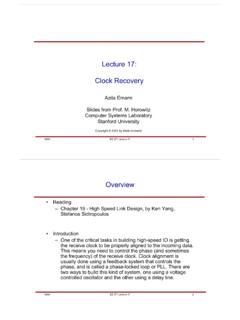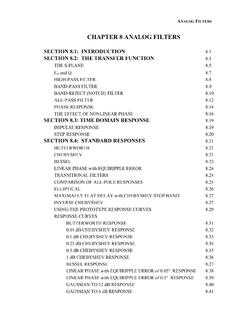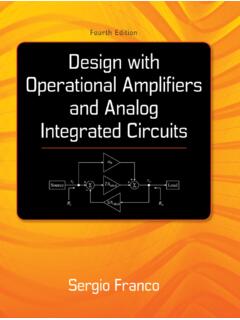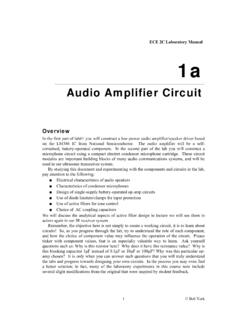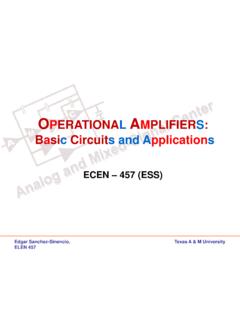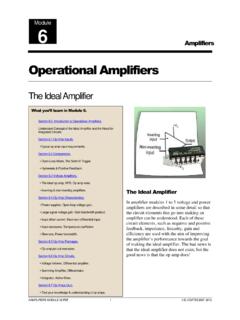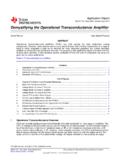Transcription of Introduction Vacuum Tube Op Amps Solid ... - Analog Devices
1 OP AMP HISTORY H Op Amp History 1 Introduction 2 Vacuum Tube Op Amps 3 Solid -State Modular and Hybrid Op Amps 4 IC Op Amps 1 Op Amp Basics 2 Specialty Amplifiers 3 using Op Amps with Data Converters 4 Sensor Signal Conditioning 5 Analog Filters 6 Signal Amplifiers 7 Hardware and Housekeeping Techniques OP AMP APPLICATIONS OP AMP HISTORY Introduction CHAPTER H: OP AMP HISTORY Walt Jung The theme of this chapter is to provide the reader with a more comprehensive historical background of the operational amplifier (op amp for short see below). This story begins back in the Vacuum tube era and continues until today (2002).
2 While most of today's op amp users are probably somewhat familiar with integrated circuit (IC) op amp history, considerably fewer are familiar with the non-IC Solid -state op amp. And, even more likely, very few are familiar with the origins of the op amp in Vacuum tube form, even if they are old enough to have used some of those Devices in the 50's or 60's. This chapter of the book addresses these issues, with a narrative of not only how op amps originated and evolved, but also what key factors gave rise to the op amp's origin in the first place. 1 A developmental background of the op amp begins early in the 20th century, starting with certain fundamental beginnings.
3 Of these, there were two key inventions very early in the century. The first was not an amplifier , but a two-element Vacuum tube-based rectifier, the "Fleming diode," by J. A. Fleming, patented in 1904 (see Reference 1). This was an evolutionary step beyond Edison's filament-based lamp, by virtue of the addition of a plate electrode, which (when biased positively) captured electrons emitted from the filament (cathode). Since this device passed current in one direction only, it performed a rectification function. This patent was the culmination of Fleming's earlier work in the late years of the 19th century.
4 A second development (and one more germane to amplification), was the invention of the three-element triode Vacuum tube by Lee De Forest, the "Audion," in 1906. This was the first active device capable of signal amplification (see Reference 2). De Forest added a control grid electrode, between the diode filament and plate, and an amplifier device was born. While these first tubes of the 20th century had their drawbacks, the world of modern electronics was being born, and more key developments were soon to follow. For op amps, the invention of the feedback amplifier principle at Bell Telephone Laboratories (Bell Labs) during the late 1920 s and early 30 s was truly an enabling development.
5 This landmark invention led directly to the first phase of Vacuum tube op amps, a general-purpose form of feedback amplifier using Vacuum tubes, beginning in the very early 1940 s and continuing through the World War II years. After World War II, there was then a transition period, as Vacuum tube op amps were improved and refined, at least in circuit terms. But, these amplifiers were fundamentally large, bulky, power-hungry Devices . So, after a decade or more, Vacuum tube op amps began to be replaced by miniaturized Solid -state op amps, in the 1950 s and 1960 s. 1 Note this chapter of the book is not necessarily required for the use of op amps, and can be optionally skipped.
6 Nevertheless, it should offer interesting background reading, as it provides a greater appreciation of current Devices once their beginnings are more fully understood. OP AMP APPLICATIONS A final major transitional phase of op amp history began with the development of the first IC op amp, in the mid 1960 s. Once IC technology became widely established, things moved quickly through the latter of the 20th century years, with milestone after milestone of progress being made in device performance. A Definition for the Fledgling Op Amp Although it may seem inappropriate to define what an op amp was in those early days at this point in the book, it is necessary to do so, albeit briefly.
7 This is because what is commonly known today as an op amp is different in some regards from the very first op amps. The introductory section of Chapter 1, where the discussion is more closely oriented around today's op amp definition, supplements the meaning below. The very first op amps were not even called such, nor were they even called "operational amplifiers". The naming of the device came after the war years, in 1947. For this historical discussion, it may be more clear to call one of these first op amps a general-purpose, DC-coupled, high gain, inverting feedback amplifier .
8 This of course is a loose definition, but it nevertheless fits what transpired. General-purpose may be interpreted to mean that such an amplifier (or multiple amplifiers) operates on bipolar power supplies, with input and output signal ranges centered around 0V (ground). DC-coupled response implies that the signals handled include steady-state or DC potentials, as well as AC signals. High gain implies a magnitude of DC gain in excess of 1000 (60dB) or more, as may be sufficient to make system errors low when driving a rated load impedance. Inverting mode operation means that this feedback amplifier had, in effect, one signal input node, with the signal return being understood as ground or common.
9 Multiple signals were summed at this input through resistors, along with the feedback signal, via another resistor. Note that this single-ended operating mode is a major distinction from today's differential input op amps. Operation of these first feedback amplifiers in only a single-ended mode was, in fact, destined to continue for many years before differential input operation became more widespread. A feedback amplifier of this type could be used in a variety of ways, dependent upon the nature of the feedback element used with it. This capability of satisfying a variety of applications was later to give rise to the name.
10 So, given this background, op amp history can now be explored. OP AMP HISTORY Introduction SECTION H-1: Introduction Setting the Stage for the Op Amp Op amps are high gain amplifiers, and are used almost invariably with overall loop feedback . The principle of the feedback amplifier has to rank as one of the more notable developments 20th century right up there with the automobile or airplane for breadth of utility, and general value to engineering. And, most importantly, such feedback systems, although originally conceived as a solution to a communications problem, operate today in more diverse situations.










